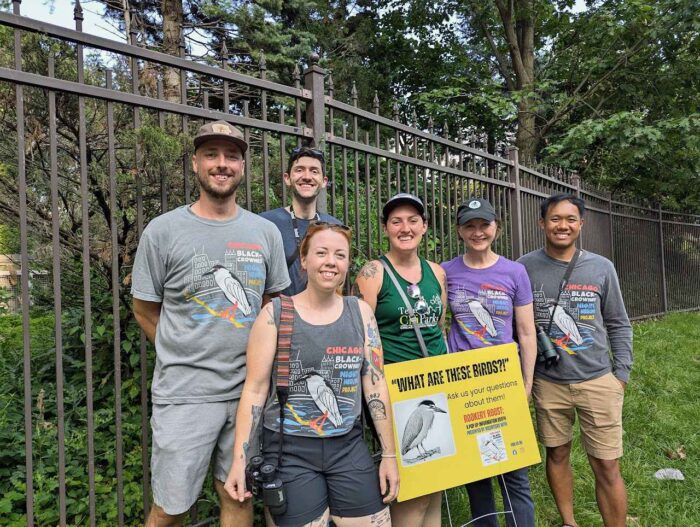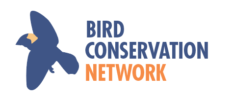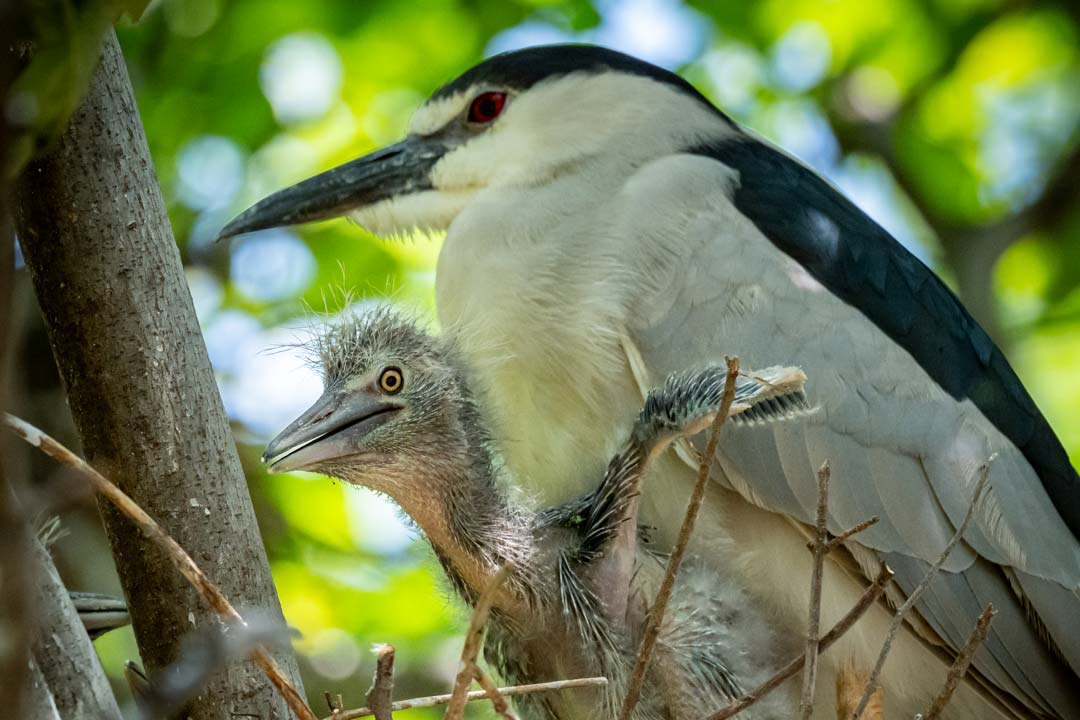Though the Black-crowned Night Heron’s conservation status is ranked “least concern” worldwide, its imperiled status in Illinois highlights why attention must be paid to species facing continued regional declines. The Chicago Black-crowned Night Heron Project represents first steps toward the longer-term work needed to develop successful restoration and conservation programs. The goal of this project is to diversify Black-crowned Night Heron nesting sites across Illinois over the next several decades.
Thus far in 2024, the team has made great strides in field research, public engagement and awareness, and new conservation connections.
TOP PHOTO: A young chick and parent BCNH at the Lincoln Park Zoo rookery. Photo by Russ Smith.
2024 FIELD SEASON RECAP
The research team—a collaborative effort between the University of Illinois Urbana-Champaign, Illinois Department of Natural Resources, and Lincoln Park Zoo— had the following milestones during the 2024 field season:
- Two conspecific sites set up to attract BCNH (Big Marsh Year 2 and Lake County Year 1) were regularly monitored this season. While there was evidence of roosting, no BCNH nesting behaviors were observed. Dispersing BCNH may notice these sites to investigate for nesting next year.
- Researchers banded 12 juvenile night herons at a dispersed breeding site in Emiquon Preserve (not in the former rookery site there) and also monitored a small rookery in Champaign.
- Sixteen adult BCNH were tagged with satellite transmitters. The trackers should last for several years and have already added to knowledge on the herons’ adaptability and site fidelity.
- Tagged night heron A24’s overwintering stay in Florida in 2023–24 opened dialogue between UIUC and the Seminole Tribe that manages Brighton Reservation in the Everglades/Lake Okeechobee area about land management strategies for waterbird conservation (read more here). A24 successfully returned to Chicago for the 2024 season and was observed parenting chicks in the rookery.
- Twenty-eight juveniles in the Lincoln Park Zoo colony were also banded. The Zoo team collected blood samples, mouth and cloacal swabs, and feathers to assess disease exposure, parasite load, and heavy metal burden for adults and chicks.
LINCOLN PARK ZOO ROOKERY UPDATE
While March 13, 2024, was the earliest BCNH return on record at the Zoo, cold weather delayed continued presence there until March 25. Adult BCNH abundance at the rookery was 695 birds by mid-May. The first sign of eggs was observed on April 25, the first chick May 6, and the first fledgling on May 27. The first fully flighted chick was observed on June 10. As of June 28, 81 adults and 485 juveniles were counted.
PUBLIC OUTREACH RECAP
Illinois Audubon Society and the Chicago Black-crowned Night Heron Project are partnering to raise awareness and funding for this research.
- Illinois Audubon Society’s “Twilight in the Rookery” event in Lincoln Park Zoo on May 9th, a limited-capacity fundraising event, was sold-out and successful. Divided into three "tracks," attendees learned about each aspect of the project from the conservation need to the urban wildlife ecology studies to the tracking and conspecific research.
- Chicago BCNH Project hosted free public Rookery Roosts outside Lincoln Park Zoo weekly from April to August, tabled at the Indiana Dunes Birding Festival in May, posts daily on social media, and continues a Chicago BCNH Project logo merchandise campaign to fund research via IAS.
- Public attention is growing. In August, the project was featured in a segment on WGN.

ABOVE: A team of volunteers with the Chicago BCNH Project at a “Rookery Roost” outside Lincoln Park Zoo. Photo by Amy Lardner.
CITIZEN SCIENCE ENGAGEMENT
Opportunities for the public to get involved in these efforts include:
- Download the Max Planck Institute's free Animal Tracker app to follow the movements of all 15 active night herons as they disperse from the rookery later this summer and, we hope, return next year. (One of the original 16 tagged birds dropped its satellite tracker into the bear enclosure at the Zoo where it was played with and destroyed by the bears—a unique site risk of a heron rookery located in an urban zoo!)
- Report any banded night herons you observe. These citizen science reports help the researchers learn more about where the birds spend their time: https://arcg.is/0vKHPW0
- The research team continues to be interested in any observations of potential or likely BCNH nesting sites in Illinois. Please contact Brad Semel of the Illinois Department of Natural Resources at semel@illinois.gov.
SUPPORT THE CHICAGO BCNH PROJECT
You can make a donation or buy logo'ed merchandise (all proceeds support the project) at the BCNH page on the Illinois Audubon Society’s website: https://illinoisaudubon.org/bcnh-project/.

